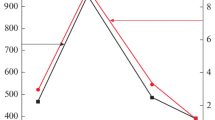Abstract
As a new type of photoelectrode, TiO2/Ni thin-film electrode was prepared by dip-coating technique. The structural and surface morphology of electrode was examined by X-ray diffraction (XRD) and scanning electron microscope (SEM). Effects of initial phenol concentration, pH value, number of film layers, voltage of electrical bias applied, variation of inorganic salt type and types of dissolved gas on the photoelectrocatalytic (PEC) degradation of phenol using ultraviolet (UV) illuminated TiO2/Ni thin-film electrode were investigated. The mechanism of PEC degradation of phenol was also studied by analyzing reaction intermediates.
Similar content being viewed by others
References
Bickley, I. B., Gonzalez, C. T. and Lees, J. S., “A Structural Investigation of Titanium Dioxide Photocatalysts”,J. Solid State Chenu,92, 178 (1991).
Candal, R. J., Zeltner, W. A. and Anderson, M. A., “TiO2-Mediated Photoelectrocatalytic Purification of Water”,J. Adv. Oxidat. Technol., 3(3), 270 (1998).
Carey, J. H., Lawrence, J. and Tosine, H. M., “Photodechlorination of PCB’s in the Presence of Titanium Dioxide in Aqueous Suspension”,Bull, of Environ. Contam. Toxicol., 16(6), 697 (1976).
Choi, A., Termin, W. and Hoffmann, M. R., “The Role of Metal Ion Dopants in Quantum-Sized TiO2: Correlation Between Photoreactivity and Charge Carrier Recombination Dynamics”,J. Phys. Chem, 98, 13669 (1994).
Kesselman, J. M., Lewis, N. S. and Hoffman, M. R., “Photoelectrochemical Degradation of 4-Chlorocatechol at TiO2 Electrodes: Comparison Between Sorption and Photoreactivity”,Envir. Sci. Technol., 31(8), 2298 (1997).
Kim, D. H. and Anderson, M. A., “Photoelectrocatalystic Degradation of Formic Acid using a Porous TiO2 Thin-film Electrode”,Environ. Sci. Technol., 28(3), 479 (1994).
Leng, W. H., Liu, H, Cheng, S. A., Zhang, J. Q. and Cao, C. N., “Kinetics of Photocatalytic Degradation of Aniline in Water over TiO2 Supported on Porous Nickel [J]”,Journal of Photochemistry and PhotobiologyA: Chemistry, 131, 125 (2000).
Li, X. Z. and Li, F. B., “Study of Au/Au3+-TiO2 Photocatalysts Toward Visible Photo-oxidation for Water and Wastewater Treatment;Environ. Sci. Technol., 35(11), 2381 (2001).
Li, X. Z., Li, F. B., Fan, C. M. and Sun, Y. P., “Photoelectrocatalytic Degradation of Humic Acid in Aqueous Solution using a Ti/TiO2 Mesh Photoelectrode”,Water Res., 36(9), 2215 (2002).
Lu, M. C., Roam, G. D., Chen, J. N. and Huang, C. P., “Adsorption Characteristics of Dichlorvos onto Hydrous Titanium Dioxide Surface”Water /tes., 30(7), 1670 (1996).
Morison, S. R., “Electrochemistry at Semiconductor and Oxidized Metal Electrodes”, Plenum Publishing Corp., New York, N. Y. (1984).
Ollis, D. F., Pelizzetti, E. and Serpone, N., “Photocatalyzed Destruction of Water Contaminants”,Envir. Sci. Technol., 25(9), 1522 (1991).
Park, D. R., Ahn, B. I., Park, H. S., Yamashita, H. and Anpo, M., “Photocatalytic Oxidation of Ethylene to CO2 and H2O on Ultrafine Powdered TiO2Photocatalysis: Effect of Presence of O2 and H2O and the Addition of Pt”,Korean J. Chem. Eng.,18, 930 (2001).
Schlafani, A. and Hermann, J. M., “Comparison of the Photoelectronic and Photocatalyticactivitis of Various Anatase and Rutile Forms of Titania in Pure Liquid Organic Phases and in Aqueous Solutions”,J. Phys. Chem., 100, 13655 (1996).
Tanaka, K., Capule, M. F V. and Hisanaga, T., “Effect of Crystallinity of TiO2 on its Photocatalytic Action”,Chem. Phyl. Lett., 187(1-2), 73 (1991).
Tang,Walter, Z. and Huren, An., “UV/TiO2 Photocatalytic Oxidation of Commercial Dyes in Aqueous Solutions”,Chemosphere, 31(9), 4157 (1995).
Vinodgopal, K., Hotchandani, S. and Kamat, P. V., “Electrochemically Assisted Photocatalysis: TiO2 Particulate Film Electrodes for Photocatalytic Degradation of 4-Chlorophenol”,J. Phys. Chem., 97, 9040 (1993).
Vinodgopal, K. and Kamat, P. V., “Combine Electrochemistry with Photocatalysis [J]”,Chemtech, 4, 18 (1996).
Vulliet, E., Emmelin, C, Chovelon, J. M., Guillard, C. and Herrmann, J. M., “Photocatalytic Degradation of Sulfonylurea Herbicides in Aqueous TiO2”,Applied Catalysis B: Environmental, 38(2), 127 (2002).
Yu, J. and Zhao, X., “Effect of Surface Treatment on the Photocatalytic Activity and Hydrophilic Property of the Sol-gel Derived TiO2 Thin Films”,Material Research Bulletin, 36(1-2), 97 (2001).
Author information
Authors and Affiliations
Corresponding author
Rights and permissions
About this article
Cite this article
Xiaoli, Y., Huixiang, S. & Dahui, W. Photoelectrocatalytic degradation of phenol using a TiO2/Ni thin-film electrode. Korean J. Chem. Eng. 20, 679–684 (2003). https://doi.org/10.1007/BF02706907
Received:
Accepted:
Issue Date:
DOI: https://doi.org/10.1007/BF02706907




